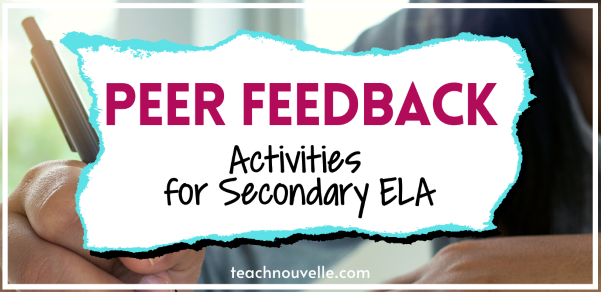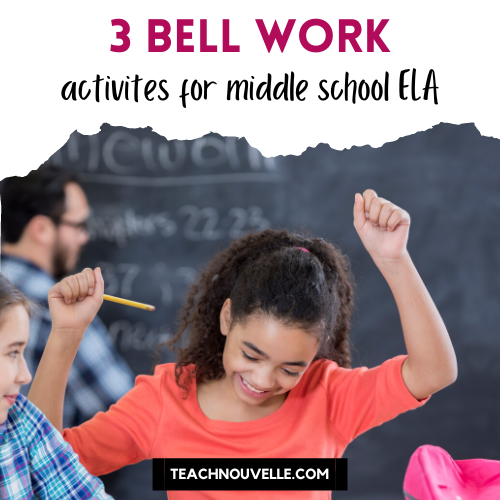These activities for teaching peer feedback in ELA will help students learn to give (and receive) constructive criticism.
Teaching Peer Feedback in ELA
Do you include opportunities for peer feedback in your classroom? If you haven’t done it before or you want to amp up your process, this is your year! Peer feedback is the perfect tool for fostering collaboration and critical thinking in Secondary ELA.
I read The Anti-Racist Writing Workshop by Felicia Rose Chavez this summer, and I see so many possibilities for improving the way we have students present their work and receive feedback. I’ll be sharing these throughout the year, but I wanted to start today with talking about peer feedback.
One of the biggest “ah-ha” moments for me in reading this book was that feedback should be an active process in which the creator takes part. Creators’ stories and experiences mediate the work they produce, so students should be in conversation.
So, let me break this down some…
What does good peer feedback look like?
Effective peer feedback is:
- Formative (not summative)
- Actionable
- Relevant
✔ Formative: After a good peer feedback session, writers or presenters have the opportunity to revise their work to integrate peer feedback.
I used to have students give “peer feedback” after presentations, but this makes no sense. At this point, your best hope is that students will remember what their peers said and make adjustments in their next presentation. But is this reasonable? No. Students will forget by the time their next presentation rolls around next week, next month, or next quarter.
Instead, use peer feedback for the drafting process of writing. For presenting, consider using peer feedback in small groups before presenters show their work to the entire class. That way, they can implement their peers’ feedback on the same project and get actual results.
When I set students up to give TAG feedback in a Writer’s Workshop, writers revise their work after this session.
✔ Actionable: Good feedback should be attainable for the creator. For example, let’s say a writer needs more supporting evidence in a research paper. It’s overwhelming to imagine revising an entire paper in this manner! Instead, students can identify one or two paragraphs that they can improve with a specific action step.
✔ Relevant: Students are humans, and they don’t want to waste their time. They know some revisions are going to have a bigger impact than others. Help your feedback givers identify the most impactful opportunities for revision.
How to teach students to give good peer feedback
In my Peer Feedback Activities Bundle, one resource provides examples of student feedback and helps students provide feedback on high-order and low-order skills. Students practice giving feedback on a model paragraph before ever looking at a peer’s paper.
You can practice feedback on model paragraphs in small groups. Students can work with their classmates to share 2-3 feedback statements that are formative, actionable, and relevant. Then, you can mix up groups and do the process again. You can give groups a full paper a couple days later to expand their skills.
You can also provide some mock-up feedback on the model paragraph and have students “edit” it. This is a big meta exercise! Students are giving feedback on feedback, lol.
Here are some examples of non-constructive feedback I share with students. Then, they read the mock-up paragraph or paper and revise the feedback to strengthen it.
✖ This paragraph is too short.
✔ You can provide a second example to strengthen this claim.
✖ Organization
✔ It’s easier to follow the “flow” of your paper if you present your claims in the same order as your thesis.
✖ I don’t understand.
✔ When you say “things” in this last sentence, what are you referring to?
Should you grade peer feedback?
If you’d like to grade feedback, consider doing so during the “feedback training” I mentioned above on fake/model content. This avoids implicating the creator in the grade of the feedback giver.
But, overall, I don’t think you should grade peer feedback. It’s a good idea to check in on it and make sure student feedback is staying formative, actionable, and relevant, but the end result needs to be the communal effort to lift up peer creators.
Why Peer Feedback is important
Peer feedback is important because it helps all student creators understand how their work affects others. It moves writing and presenting out of their void and into the real world, where work has an audience. Moreover, it helps position all students as process experts who can give insights on improving any creation.
Be sure to grab this Peer Feedback Activities Bundle for three tools to amp up your peer feedback this year!
Do you have a favorite peer feedback activity, or a method that really resonates with your students? Share in the comments so we can all learn!
Happy teaching!







No Comments